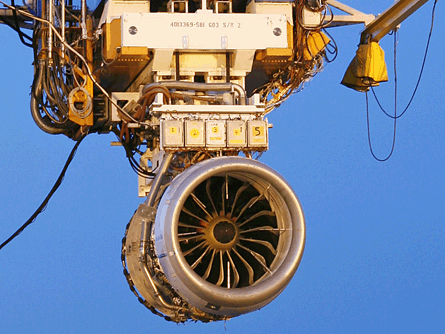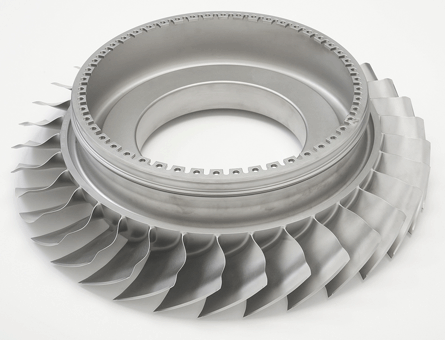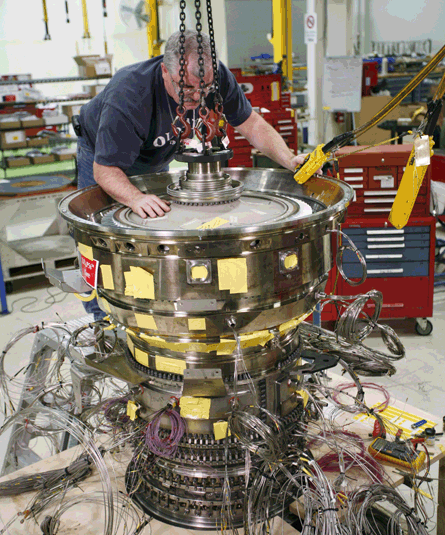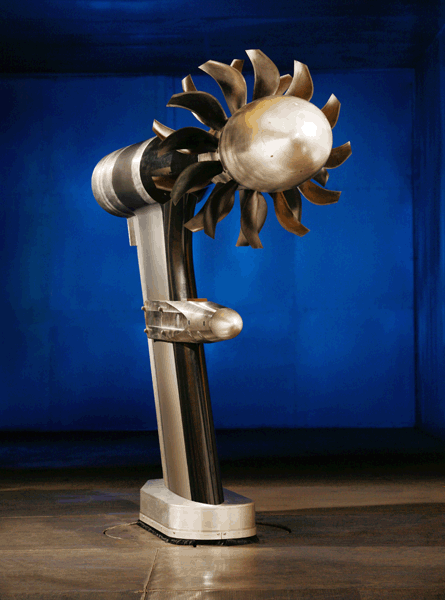California-based vintner Paul Masson was perhaps best known for a slogan made famous on TV commercials for the winery in the 1970s by the late Orson Welles: "We will sell no wine before its time."
Today the same slogan nicely describes Franco-US engine maker CFM International and its approach to introducing new technology. In this case, the "wine" is the Leap X1C turbofan engine selected by China's Comac for its C919, a 150-passenger single-aisle twinjet set to enter service around 2016. CFM, the 50/50 joint venture between General Electric and Snecma, is most famous for building the CFM56 turbofans, an engine that now powers nearly 8,500 commercial and military aircraft including the Airbus A320 and Boeing 737.
 |
|---|
© CFM InternationalFull scale demonstrator of a CFM Leap X 3-D woven RTM (resin transfer moulding) composite fan installed on a CFM56-5C engine |
"We've been working on a replacement core for the CFM56 since 1999," says CFM Leap programme director Ron Klapproth. "Given that the earliest entry into service for the new engine is 2015, it will have been 16 years of development time." The decade-plus grind is also true of other key technologies embedded in the X1C, the launch application for the successor to the CFM56 line.
Persistence in culling those technologies over the years helped sway Comac to choose the X1C over competitors, including Pratt & Whitney and Rolls-Royce, even though CFM's offering was different from its CFM56 architecture. "We had done a tremendous amount of work already on the technology that goes into the product," says Chaker Chahrour, executive vice-president of CFM. "We convinced Comac we had done that work."
Chahrour says CFM focused specifically on the C919 programme, despite open competitions at the time for the Irkut MS-21 and Bombardier CSeries projects. Bombardier and Irkut both selected P&W's geared turbofan for their next-generation aircraft. "We purposely focused on China," says Chahrour, noting that the country has become "a bigger and bigger player in the aviation market as a consumer".
From a CFM perspective, China represents about 10% of CFM sales in terms of existing and ordered aircraft. Chahrour estimates a potential market for more than 2,000 C919s over the next 20 years, with CFM as the sole Western source for its engines. Comac is in the midst of a joint definition phase with vendors, to be completed early in 2011.
 |
|---|
© CFM InternationalCFM used 3D aerodynamic models to develop the unusual blade shapes in the HPC |
The turbofans powering China's largest jet project to date will feature a long list of improvements over the latest CFM56, all enshrouded by a Nexcelle integrated propulsion system that itself may provide up to an additional 2% reduction in fuel burn.
The development of the next-generation engine technologies began in earnest in 2005 when CFM launched the leading edge aviation propulsion (Leap) effort, its largest investment in technology to date, with the intention of developing two new products: a new 33,000lb (134kN)-class centreline turbofan engine with 15% lower fuel burn for entry into service around 2016; and a longer-term, ultra-high bypass unducted fan engine to cut fuel burn by 25% in about 2025.
Momentum increased in 2008 when CFM decided to "put a stake in the ground" by committing to develop a ducted Leap X demonstration engine, with 2016 in mind as a certification date. "At the time Boeing and Airbus were talking a 2018 or so service entry for a new narrowbody", says Klapproth. "We knew 2016 was the right time from a CFM perspective to demonstrate these technologies."
The company also started talking to Comac and others to find a launch customer for the engine at that time. Performance goals included 16% lower fuel burn compared with the latest CFM56 upgrades from 2007, 50% lower NOx emissions than CAEP 6 and 10-15EPNdB noise margin compared with Stage 4 requirements.
RE-ENGINING FOCUS
Klapproth says Airbus and Boeing in 2009 began to focus on re-engining instead, leading CFM to split the ducted Leap X development into two phases: a 2014 Leap X with 10-15% reduction in fuel burn depending on fan size and other to-be-determined parameters for the C919 and re-engining programmes, and a 2016 Leap X that would meet the original fuel efficiency goals with new lightweight hot-section blade technologies, such as ceramic matrix composites or titanium aluminide. Airbus and Boeing are expected to decide whether to launch A320 and 737 re-engining programmes by the end of the year.
Regardless of the Leap X service entry, the engines require a massive infusion of technology at the start, much of it from GE's experience with the GE90. "When you set the goals of 16% better fuel burn [with the NOx and noise goals], it drives you to an architecture that looks more like a smaller version of a widebody engine," says Klapproth. "As you go up in bypass, the fan diameter gets larger, so you have weight and drag implications to deal with. You deal with the weight issue using composite fan blades and casings and high-temperature composites in the hot section of the engine."
 |
|---|
© CFM International |
For Leap X, CFM increased the CFM56's 5.5:1 bypass ratio to around 11:1, slightly larger than that of the GE90. Composite fan blades, which GE used for its open rotor demonstrator in the 1980s and later incorporated in the GE90 fan, allow for an increase in fan size without the associated weight penalty.
Klapproth says the X1C fan will have a 190.5cm (75in) "plus or minus an inch" diameter with 18 blades, compared with 36 titanium blades for a CFM56-5C and 24 blades for a CFM56-7B. Combined with a new lighter fan containment structure, total weight savings will be 455kg (1,000lb) per aircraft, says CFM. Bypass ratios for re-engining programmes might be 9-10:1, says Klapproth.
Composite blades for the GE90 are made using a two-dimensional laminate layup. Smaller blades for the Leap X built using that technique would not be strong enough to handle birdstrike requirements. "It's a lot easier to handle a 2.5lb bird strike with a 128in diameter blade [for the GE90] compared to a 75in blade," says Klapproth. For strength, Snecma developed a loom that will weave and stitch the blade's composite fibres in three dimensions.
Coupled with the higher bypass ratio, CFM also doubled the pressure ratio in the high-pressure compressor to roughly 20:1 for thermal efficiency and fuel burn, characteristics similar to that of a widebody engine. Klapproth says having that high a pressure ratio in a smaller engine that will fly 10 cycles a day as opposed to two will be a challenge in terms of durability, and requires the introduction of advanced blade materials.
STAGE NUMBERS
The X1C will have a 10-stage HPC (1-4 are blisks, 5-10 are blades) and a two-stage high- pressure turbine (HPT), up from one stage for the CFM56. CFM has not specified its number of low-pressure stages. Snecma provides the fan and low-pressure modules. GE builds the core, including the HPC, combustors and HPT.
A consequence of a higher pressure ratio is increased NOx emissions, which will require new combustor technologies where localised "hot spots" produce the gases. The answer in part was to include a lean burn combustor rather than a rich burn design, traditionally used for extra flameout protection. Lean burn technology was developed for the CFM56 and is certificated on the GEnx programmes for the Boeing 787 and 747-8. The Leap X1C will use second-generation lean burn technology.
CFM has completed full-scale, aerodynamic, acoustic, birdstrike and blade-out tests on the new fan. A second phase of testing is under way with the first Leap X core, "eCore1", instrumented with around 1,000 sensors, with a second, X1C, representative core in development for 2011 testing and a third and fourth to follow before the first complete engine is ready for testing in early 2013.
"We want to do all that development work in our factory, not on the wings of our customers," says Klapproth.
OPEN ROTOR: WILL AIRLINES SLOW DOWN FOR SAVINGS?
When airframers market the attractiveness of unducted fan technology, aka open rotor, to airlines for the next-generation single-aisle aircraft around 2025, an unusual question is likely to be part of the discussions: are you willing to trade cruise speed for fuel savings?
The physics behind the question is this: while single-aisle replacement studies use the Boeing 737's Mach 0.78 cruise speed as a baseline for open rotor comparisons, it turns out that the physics of an open rotor make the engine's twin-counter-rotating fans more efficient when flying just a bit more slowly, perhaps M0.75. CFM International says open rotor by itself can deliver as much as a 26% reduction in fuel burn over today's models. The efficiency comes in large part from its ultra-high bypass ratio, which however will require a rotor with the diameter of a narrowbody aircraft, about 4.6m (15.1ft).
Open rotor could be CFM's answer in the long term (2025) to the fuel economy equation, its intermediate solution being the more traditional Leap X turbofan replacement for the CFM56 engine. CFM launched the Leap (leading edge aviation propulsion) in 2005 to come up with the next-generation CFM56, following up on advances from its 1999 Tech56 initiative. "It is the largest investment in technology in the history of CFM," says Ron Klapproth, CFM programme director for Leap.
 |
|---|
© CFM International |
Open rotor research was hot at General Electric in the 1980s, when the company flew its 3.35m-diameter unducted GE36 engine on two aircraft types. Although noise, blade pitch control and airframe integration were found to be key issues to be resolved, fuel prices dropped and so was the research.
With the programme now reborn, complete with 30 years of technology advances, CFM is testing new subscale lower-noise composite fan blades in three windtunnels around the world. "As we get data back, we're getting more and more bullish on the acoustic challenges," says Klapproth. Still to be mastered however is the pitch change mechanism needed, which he calls "the number one challenge" to make open rotor a viable product.
"Our approach has been to design an open rotor that flies at M0.78 with the computational fluid dynamics tools we have, and we have come up with some pretty nice designs there," he says. "If you lower the cruise mach number however, the blades will get more efficient." For airlines, cruise speed is intimately tied to block time.
Klapproth notes that for a 925km (500nm) flight, flying at M0.78 versus M0.75 will not result in much difference in block time, but the same is not true for a 3h mission. "We hear mixed signals on how open airlines are to the speed," says Klapproth. "Some want all the fuel burn improvements you can provide; others, particularly high-cycle airlines, are cautioning us against a slower cruise speed. It might only be a few minutes per flight, but that adds up to real time at the end of the day."
Source: Flight International























